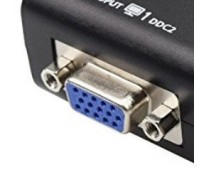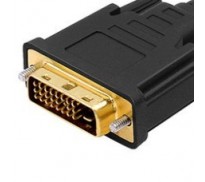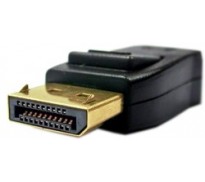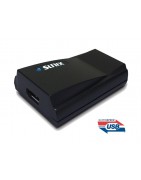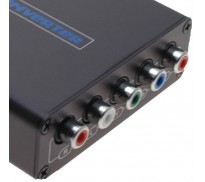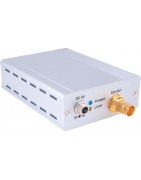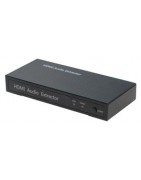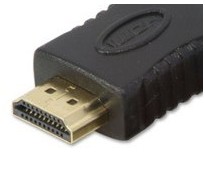-
Produkter
-
Netværksprodukter
-
Switche
- Routere
-
Antaira netværksprodukter
- Wifi, Access Point, Client
- Wifi Routers
- Gigabit switch - unmanaged
- Gigabit switch - managed
- IP67 Wifi, Access Point, Client, Bridge, Repeater
- 10Gbit switch - unmanaged
- Mediekonverter - RJ45 til fiberkabel
- Rack-monteret switch
- 100Mbit switch - unmanaged
- 100Mbit switch - managed
-
Trådløs / Wifi / LTE / BT / LoRa / Modems / Antenner
- PoE netdel / PoE injektor / PoE splitter / PoE Extender
- Mediekonverter - RJ45 til fiberkabel
- SFP moduler / GBIC
- LAN extender
- VDSL - LAN via 2-tråd / Coax
- Mediekonverter - BNC / AUI
- Alternativ till analog telefonlinje. Analog telefon för GSM
- Netværkskort / Adapter via USB
- Serielportserver / Serial Device Server
- Portservere med USB / USB over netværk
- Printservere
- Værktøj og tilbehør
- Transient-beskyttelse / Galvanisk-isolation
- AMIT Industrial 4G/5G produkter
-
Switche
-
Kabler / Fiber / Omsætter / Stik
-
Fiberkabler / Tilbehør
- LC / LC - Multi Mode og Single Mode
- SC / SC - Multi Mode og Single Mode
- ST / ST - Multi Mode og Single Mode
-
Stål-armerede fiberkabler Multi Mode og Single Mode
- E2000/APC
- Kabler med vinklede stik
- Easy Bend (flexible)
- Fiberkabler m/lys
- Konverteringskabel stik x til stik y
- Pigtail LC/SC/ST
- Uniboot
- MTRJ Fiber optiske kabler
- Fiber-samler - hun / hun
- Støvhætter
- Fiberstik
- Værktøj / Tilbehør
- Toslink til audio
-
Netværkskabler / Tilbehør
- Vandtæt RJ45 / Fiber / USB / VGA / HDMI / STIK
-
USB 2.0 / 3.0 / 3.2 / 4
- Thunderbolt
- HDMI
- Displayport
- USB Forlænger / Extender
- RS232 Seriel / Parallel LPT
- DVI
- VGA kabler
- Coax-kabel / Antenne-stik
- Adapter
- Vinkelstik
- Løse stik DB9, DB25, RJ45,RJ11, IDC, DC, PWR, MED FLERE
- Video- og lydkabler
- Eksterne PC-kabler
- Beskyttelse
- Værktøj og tilbehør
- SCSI
- Industrikabler / Fiber og RJ45
- Netledninger - Powerkabler
- Interne PC-kabler / strømkabler- /stik
- Fladkabler, IDC, stik
-
Fiberkabler / Tilbehør
-
Tastatur / Mus / Programmerbare
- Skærme / Monitorer / Skærm-splitter / Video-adaptere
- Video extender, Video splitter, Video konverter, Video Wall
-
Embedded-PC / Industri-PC / Panel-PC / POS
- Tablets / Notebooks / Tilbehør
-
SSD / HDD / FLASH / DVD / FDD / Medie-kopiering / RAID
- Bundkort / CPU-kort / Tilbehør
- Udvidelseskort / ExpCard / PCMCIA / Grafik
-
RS232 / RS422 / RS485 / LPT Parallel
- USB til Seriel (COM port via USB)
- Serielport Server / Serial Device Server
- Konverter / Forstærker / Isolator
- Parallel Booster/konverter
- Seriel
- Seriel & Parallel Booster / Multiplexer
- Mini PCI Express
- RS232 PCI Kort
- RS232 PCI Express Kort
- RS422/RS485 PCI Express Kort
- RS422/RS485 PCI Kort
- Seriel og Parallel Kombikort
- Parallel Kort PCI / PCIE
- USB omsættere / USB extendere / USB adaptere / Firewire
-
19" Rackskabe / PC-kabinetter / Strømskinner / Hylder / Tilbehør
-
Strømforsyninger USB / ATX / AT / Netadaptere / UPS´er
- USB Lader PD Power Delivery NaG
- Strømudtag med USB lader
- ATX
- AT - PS/2
- Strømforsyninger / netadaptere
- Strømforsyning til DIN
- DC/DC konverter
- Universal strømforsyning
- Lavspænding AC til DC omformer
- UPS / Power Bank / generator
- DC til 230 VAC invertere
- Laboratorie strømforsyning
- Solpaneler / tilbehør
- 110/220 VAC Transformere
- PICO
- PDU med Fjernkontrol / NTP Server / Atomur
- Medico IT-beslag / Monitorarme / Medico trolley
-
KVM Switch / KVM Extender
-
Datalogning / Dataopsamling / Måling
- Fjernstyring- / Måling via Ethernet og GSM
-
Industristyring / Digital I/O / Analog I/O / Relæ over ETH, USB og Seriel
- Analog I/O - mA / Volt
- Digital I/O - DI / DO / Relæ / Tæller
- Digital I/O / Analog I/O / Analog ud
- Smart I/O moduler - Web-baseret - WISE
- Smart I/O m/LOG - Web-baseret - WISE
- HMI panel / PLC Kontrollere
- Temperaturføler / Transmitter
- Gateway / Protokol konverter
- Digital output / Relæer
- ControlByWeb I/O moduler
- Teracom Systems / Overvågning / Datalogning
- Dataopsamling A/D, D/A - Input- / Outputkort
- Terminalkort
-
Elektronisk lås / Adgangskontrol / Alarmer
- Adgangskontrol / Tidsregistrering
- El-låse / el-slutblik / el-holdemagnet / el-knapper
- Alarmer / GSM-alarmer
- Tyverisikring / GSM-alarm
- Fingeraftrykslæser / Biometric
- Irisscanner / Biometric
- Lysbarriere
- Mikrobølgebarriere
- Perimeter / IR-barriere
- Pullerter til vejspærring
- Hardwarelås / USB-dongle
- Wiegand
- Strømsparer
- Videoovervågning / Videokamera / Optager
-
RFID / Stregkode / Magnetkode / TAGs / POS
- GPS- tracking / Person-tracking / Dements-sporing
- PLC / HMI
-
Interface Force vejeceller / Vejeinstrumenter
- Testudstyr / Programmering / Logik
- ICPDAS Industri automation
- Korenix produkter
- INSYS Industriel automation
- Restsalg / Demovarer
-
Netværksprodukter
-
Vidensdatabase
-
Netværk
- Hvad er PoE ? [Power over Ethernet] - Nov 2021 - DANBIT A/S
- PoE Switch ⇒ Alt du skal vide om en PoE Switch [2021]
- Opsætning af trådløse netværk - DANBIT A/S
- Hvordan fungerer SFP moduler?
- Forskellen på fiberkabler OM1, OM2, OM3 og OM4
- Forklaring – TCP/IP - DANBIT A/S
- Hvad er et VDSL Modem? ⇒ Få svaret her
- Netværksbegreber - Alle begreber beskrevet
-
Alt om PC'er
- Hvad er GPU?
- Kundespecificeret løsninger opbygges efter ønsker og behov.
- Information om 80PLUS
- Fjernbetjening af computer over internettet - DANBIT A/S
- Hvad er Express Card? ⇒ Bliver klogere her - DANBIT A/S
- Hvad er RAID ? - DANBIT A/S
- Hvad er PCI Express ? - DANBIT A/S
- Passivt buskort
- Forklaring om USB 3.0 teknologien
- XP Embedded - DANBIT A/S
- Nye typer harddiske på markedet
- Video
-
Digital I/O, PLC, HMI, GPS, Logger
- Eksempler af HMIxx
- Typer af optoisolerede ind- og udgange
- Hvad betyder TTL kompatibel?
- CONTROLBYWEB I/O MODULER
- Web-baseret dataopsamling - enkelt og nemt
- Hvad er en datalogger? Og hvad bruges den til? - [Forklaret] - DANBIT
- Fjernkontrol og styring via Ethernet - WISE controllere
- Styring via Ethernet
- Styring og dataopsamling
- GPS-TRACKER
-
Kabler / stik
- Komplet stikoversigt over USB, Seriel, Fiber, SATA, VGA og flere - DANBIT A/S
- Stiktyper
- Generel information om fiberkabler [Forklaret 2021] - DANBIT A/S
- Hvordan virker skærmede kabler - DANBIT A/S
- USB 3.1 type-C
- Hvad er forskellen på Cat 5e og Cat 6 kabler ? [Forklaret] - DANBIT
- Hvad betyder farven for fiberkabler?
- Hvordan kommer du udover USB begrænsningen? - DANBIT A/S
- Forskellen mellem Singlemode og Multimode fiberkabler
- Elektronik
- Seriel, Parallel
- Magnetkort, Strekkode, NFC
- Certificeringer
- Cases / Eksempler
-
Netværk
- Presse
- Om os
- Nyheder
- Cookiepolitik
Video Konverter / Omsætter / Lyd
Converting from VGA (Video Graphics Array) to Composite Video involves changing the format of the video signal to make it compatible with devices that accept composite video inputs. Here are some key points to consider when performing this conversion:
1. Signal Conversion: VGA is an analog video format commonly used for computer monitors, while composite video is also an analog format used for standard-definition video,...
Converting from VGA (Video Graphics Array) to Composite Video involves changing the format of the video signal to make it compatible with devices that accept composite video inputs. Here are some key points to consider when performing this conversion:
1. Signal Conversion: VGA is an analog video format commonly used for computer monitors, while composite video is also an analog format used for standard-definition video, typically found in older TVs or certain displays. The conversion process involves adapting the VGA signal to a composite video format.
2. Resolution and Compatibility: VGA typically carries higher resolutions than composite video. When converting from VGA to composite, be aware that the composite video format has lower resolution. This means that some detail and clarity may be lost in the conversion.
3. Converter or Adapter: To perform this conversion, you will need a VGA to composite video converter or adapter. These devices come in various forms, including VGA to RCA (the typical connectors for composite video) adapters and standalone converter boxes. Ensure that the converter you choose is compatible with your specific devices and supports the resolution you need.
4. Supported Resolutions: Check the converter's specifications to see which VGA resolutions it can handle and whether it can downscale them to composite video's lower resolution. Make sure it meets your requirements.
5. Power Supply: Some converters may require an external power source, while others can be powered through the VGA connection. Ensure that you have the necessary power supply if required.
6. Audio Conversion: If audio is also involved, you may need a converter that can handle VGA audio, usually carried through a 3.5mm audio jack, and convert it to composite audio.
7. Compatibility with Devices: Ensure that the devices you're connecting the converter to (e.g., VGA source and composite video display) are compatible with the converter's signal format. Check the inputs and outputs of all devices involved.
8. Cabling: Ensure you have the appropriate cables to connect the VGA source to the converter and the converter to the composite video display.
9. Signal Quality: The quality of the conversion can vary depending on the converter's quality. Higher-quality converters can produce better results with less signal degradation.
10. Aspect Ratio and Frame Rate: Be aware that VGA typically uses a different aspect ratio (4:3) than composite video (usually 4:3 or 16:9). Some converters allow you to adjust the aspect ratio and frame rate to match your desired output.
11. User Reviews and Recommendations: Before purchasing a converter, it's a good idea to read user reviews and seek recommendations to ensure that the product meets your specific needs and works well with your equipment.
In summary, converting from VGA to composite video is useful for connecting older VGA sources to displays that only accept composite video inputs. However, it's essential to choose the right converter, consider resolution and compatibility, and ensure that your devices are compatible with the conversion process to achieve the desired results.

Video Konverter / Omsætter / Lyd
Underkategorier

